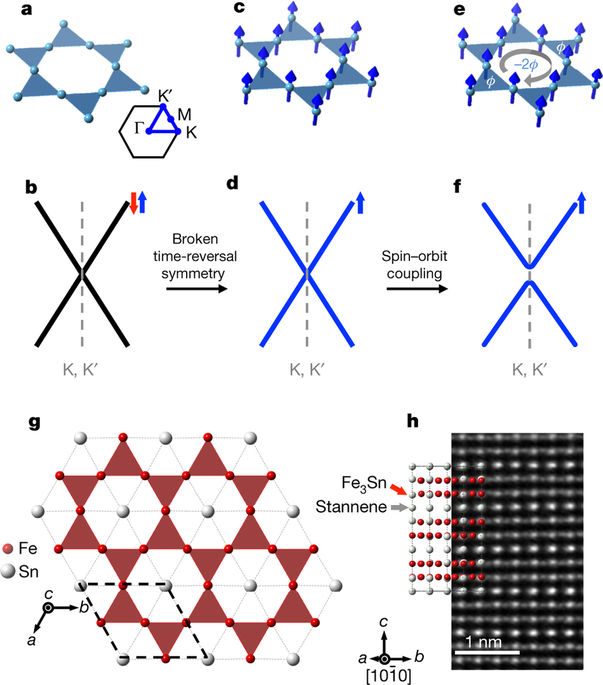Our official English website, www.x-mol.net, welcomes your
feedback! (Note: you will need to create a separate account there.)
Massive Dirac fermions in a ferromagnetic kagome metal
Nature ( IF 50.5 ) Pub Date : 2018-03-01 , DOI: 10.1038/nature25987 Linda Ye , Mingu Kang , Junwei Liu , Felix von Cube , Christina R. Wicker , Takehito Suzuki , Chris Jozwiak , Aaron Bostwick , Eli Rotenberg , David C. Bell , Liang Fu , Riccardo Comin , Joseph G. Checkelsky
Nature ( IF 50.5 ) Pub Date : 2018-03-01 , DOI: 10.1038/nature25987 Linda Ye , Mingu Kang , Junwei Liu , Felix von Cube , Christina R. Wicker , Takehito Suzuki , Chris Jozwiak , Aaron Bostwick , Eli Rotenberg , David C. Bell , Liang Fu , Riccardo Comin , Joseph G. Checkelsky

|
The kagome lattice is a two-dimensional network of corner-sharing triangles that is known to host exotic quantum magnetic states. Theoretical work has predicted that kagome lattices may also host Dirac electronic states that could lead to topological and Chern insulating phases, but these states have so far not been detected in experiments. Here we study the d-electron kagome metal Fe3Sn2, which is designed to support bulk massive Dirac fermions in the presence of ferromagnetic order. We observe a temperature-independent intrinsic anomalous Hall conductivity that persists above room temperature, which is suggestive of prominent Berry curvature from the time-reversal-symmetry-breaking electronic bands of the kagome plane. Using angle-resolved photoemission spectroscopy, we observe a pair of quasi-two-dimensional Dirac cones near the Fermi level with a mass gap of 30 millielectronvolts, which correspond to massive Dirac fermions that generate Berry-curvature-induced Hall conductivity. We show that this behaviour is a consequence of the underlying symmetry properties of the bilayer kagome lattice in the ferromagnetic state and the atomic spin–orbit coupling. This work provides evidence for a ferromagnetic kagome metal and an example of emergent topological electronic properties in a correlated electron system. Our results provide insight into the recent discoveries of exotic electronic behaviour in kagome-lattice antiferromagnets and may enable lattice-model realizations of fractional topological quantum states.
中文翻译:

铁磁性 Kagome 金属中的大量狄拉克费米子
Kagome 晶格是角共享三角形的二维网络,已知它具有奇异的量子磁态。理论工作预测,kagome 晶格也可能包含 Dirac 电子态,这可能导致拓扑和陈绝缘相,但到目前为止,这些状态尚未在实验中检测到。在这里,我们研究了 d 电子 kagome 金属 Fe3Sn2,它旨在在铁磁有序的情况下支持大块质量的狄拉克费米子。我们观察到与温度无关的内在异常霍尔电导率持续高于室温,这表明来自 Kagome 平面的时间反转对称性破坏电子带的显着 Berry 曲率。使用角分辨光电子能谱,我们在费米能级附近观察到一对准二维狄拉克锥,质量间隙为 30 毫电子伏特,这对应于产生贝里曲率诱导霍尔电导率的大量狄拉克费米子。我们表明,这种行为是铁磁态双层 Kagome 晶格和原子自旋轨道耦合的潜在对称特性的结果。这项工作为铁磁 Kagome 金属提供了证据,并提供了相关电子系统中出现的拓扑电子特性的例子。我们的结果提供了对 Kagome-晶格反铁磁体中奇异电子行为的最新发现的深入了解,并可能使分数拓扑量子态的晶格模型实现成为可能。它们对应于产生 Berry 曲率诱导的霍尔电导率的大量狄拉克费米子。我们表明,这种行为是铁磁态双层 Kagome 晶格和原子自旋轨道耦合的潜在对称特性的结果。这项工作为铁磁 Kagome 金属提供了证据,并提供了相关电子系统中出现的拓扑电子特性的例子。我们的结果提供了对 Kagome-晶格反铁磁体中奇异电子行为的最新发现的深入了解,并可能使分数拓扑量子态的晶格模型实现成为可能。它们对应于产生 Berry 曲率诱导的霍尔电导率的大量狄拉克费米子。我们表明,这种行为是铁磁态双层 Kagome 晶格和原子自旋轨道耦合的潜在对称特性的结果。这项工作为铁磁 Kagome 金属提供了证据,并提供了相关电子系统中出现的拓扑电子特性的例子。我们的结果提供了对 Kagome-晶格反铁磁体中奇异电子行为的最新发现的深入了解,并可能使分数拓扑量子态的晶格模型实现成为可能。这项工作为铁磁 Kagome 金属提供了证据,并提供了相关电子系统中出现的拓扑电子特性的例子。我们的结果提供了对 Kagome-晶格反铁磁体中奇异电子行为的最新发现的深入了解,并可能使分数拓扑量子态的晶格模型实现成为可能。这项工作为铁磁 Kagome 金属提供了证据,并提供了相关电子系统中出现的拓扑电子特性的例子。我们的结果提供了对 Kagome-晶格反铁磁体中奇异电子行为的最新发现的深入了解,并可能使分数拓扑量子态的晶格模型实现成为可能。
更新日期:2018-03-01
中文翻译:

铁磁性 Kagome 金属中的大量狄拉克费米子
Kagome 晶格是角共享三角形的二维网络,已知它具有奇异的量子磁态。理论工作预测,kagome 晶格也可能包含 Dirac 电子态,这可能导致拓扑和陈绝缘相,但到目前为止,这些状态尚未在实验中检测到。在这里,我们研究了 d 电子 kagome 金属 Fe3Sn2,它旨在在铁磁有序的情况下支持大块质量的狄拉克费米子。我们观察到与温度无关的内在异常霍尔电导率持续高于室温,这表明来自 Kagome 平面的时间反转对称性破坏电子带的显着 Berry 曲率。使用角分辨光电子能谱,我们在费米能级附近观察到一对准二维狄拉克锥,质量间隙为 30 毫电子伏特,这对应于产生贝里曲率诱导霍尔电导率的大量狄拉克费米子。我们表明,这种行为是铁磁态双层 Kagome 晶格和原子自旋轨道耦合的潜在对称特性的结果。这项工作为铁磁 Kagome 金属提供了证据,并提供了相关电子系统中出现的拓扑电子特性的例子。我们的结果提供了对 Kagome-晶格反铁磁体中奇异电子行为的最新发现的深入了解,并可能使分数拓扑量子态的晶格模型实现成为可能。它们对应于产生 Berry 曲率诱导的霍尔电导率的大量狄拉克费米子。我们表明,这种行为是铁磁态双层 Kagome 晶格和原子自旋轨道耦合的潜在对称特性的结果。这项工作为铁磁 Kagome 金属提供了证据,并提供了相关电子系统中出现的拓扑电子特性的例子。我们的结果提供了对 Kagome-晶格反铁磁体中奇异电子行为的最新发现的深入了解,并可能使分数拓扑量子态的晶格模型实现成为可能。它们对应于产生 Berry 曲率诱导的霍尔电导率的大量狄拉克费米子。我们表明,这种行为是铁磁态双层 Kagome 晶格和原子自旋轨道耦合的潜在对称特性的结果。这项工作为铁磁 Kagome 金属提供了证据,并提供了相关电子系统中出现的拓扑电子特性的例子。我们的结果提供了对 Kagome-晶格反铁磁体中奇异电子行为的最新发现的深入了解,并可能使分数拓扑量子态的晶格模型实现成为可能。这项工作为铁磁 Kagome 金属提供了证据,并提供了相关电子系统中出现的拓扑电子特性的例子。我们的结果提供了对 Kagome-晶格反铁磁体中奇异电子行为的最新发现的深入了解,并可能使分数拓扑量子态的晶格模型实现成为可能。这项工作为铁磁 Kagome 金属提供了证据,并提供了相关电子系统中出现的拓扑电子特性的例子。我们的结果提供了对 Kagome-晶格反铁磁体中奇异电子行为的最新发现的深入了解,并可能使分数拓扑量子态的晶格模型实现成为可能。











































 京公网安备 11010802027423号
京公网安备 11010802027423号